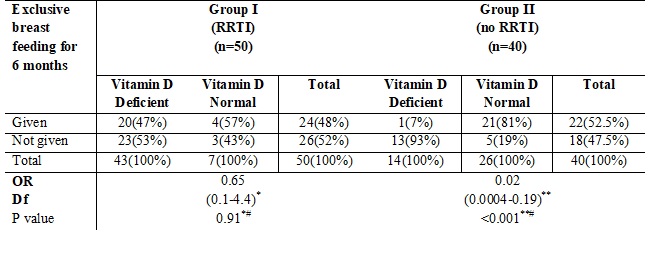A study of Vitamin-D and nutritional status in recurrent respiratory tract infections in children 1-5 years of age
Abstract
Objective:To assess and explore the association of Vitamin D deficiency with recurrent respiratory tract infections in children less than 5 years.
Design:This wasa prospective non-randomized two group design study.
Duration:One year and four months, i.e. July 2015 to October 2016.Setting:Department of Pediatrics, Bhaskar Medical College, Telangana, India.
Participants:90 children, all aged less than 5 years, attendingthe Department of Pediatrics, Bhaskar Medical College.
Methods:Out of total 90 cases, 50 children with recurrent respiratory tract Infections (RRTI)were taken as Group I, while 40 children without recurrent respiratory tract Infections were taken as Group II. After thorough clinical examination, Serum Vitamin D levels were estimatedby Radio Immune Assay (RIA) technique. Statistical analysis was done using appropriate software.
Results: Serum Vitamin D levels ranged from 20 to 140 nmol/l. It was depicted that 86% of children with recurrent respiratory tract infections had Vitamin D deficiency.Vitamin D deficiency and number of respiratory tract infections are more in male children. The mean Vitamin D level in Group I (RRTI) was low i.e. 41.7 nmol/I compared to 64.6 nmo1/1 in Group 11 (no RRTI). Vitamin D deficiency and number of respiratory tract infections were more in the 37-48 months age group. Vitamin D levels were low in children who were exclusively breast fed for 6 months (47%). Vitamin D levels were low in children who had poor exposure to sunlight (79%).
Conclusion:There was a significant association between Vitamin D levels and recurrent respiratory tract infections. Education regarding the importance and timing of sun exposure is necessary. Routine Vitamin D supplementation is recommended.
Downloads
References
2. McCollum EV, Simmonds N, Becker JE, Shipley PG. Studies on experimental rickets. XXI. An experimental demonstration of the existence of a vitamin which promotes calcium deposition. J. Biol. Chem. 1922;53:293-312.
3. Arya V, Bhambri R, Godbole MM, Mithal A. Vitamin D status and its relationship with bone mineral density in healthy Asian Indians.Osteoporos Int. 2004 Jan;15(1):56-61. Epub 2003 Sep 12.[pubmed]
4. Diazlopez B,CannataAndiaJB.Supplementation of Vitamin D and calcium;advantages and risks.Nephrol dial transplant.2006;2:2375-7.[pubmed]
5. Harinarayan CV, Ramalakshmi T, Prasad UV, Sudhakar D, Srinivasarao PV, Sarma KV, Kumar EG. High prevalence of low dietary calcium, high phytate consumption, and vitamin D deficiency in healthy south Indians.Am J ClinNutr. 2007 Apr;85(4):1062-7.[pubmed]
6. Cannenll JJ,Hollis BW,ZasloffM,HeaneyRP.Diagnosis and treatment of vitamin D deficiency.Expertopin pharmacotherapy.2008;9;107-18.[pubmed]
7. Holick MF. Sunlight and vitamin D for bone health and prevention of autoimmune diseases, cancers, and cardiovascular disease.Am J ClinNutr. 2004 Dec;80(6 Suppl):1678S-88S.[pubmed]
8. RhodesLE,Webb,Fraser,Durkin.Recommended sunlight exposure produce sufficient but not optimal 25(OH)D at UK altitudes.J Invest Dermato1.2010 May;130(5):1411-8.Epub 2010 Jan2014.
9. Rucker D Allan JA, HNanleyDA . Vitamin D Insufficiency in a population ofhealthywesternCanadians. CMAJ.2002JUN2011;166(12):1517-24.[pubmed]
10. Holick MF.THE Vitamin D deficiency pandemic:a forgotten hormone important forhealth.Public Health Reviews2010;32:267-283.[pubmed]
11. Benner A Al aliM,Hofmann. Vitamin D deficiency in healthy children in a sunnycountry :associatedfactors.Int J Food science nutrition.2009;5:60-70.[pubmed]
12. Balasubramanian S, Ganesh R. Vitamin D deficiency in exclusively breast-fed infants. Indian J Med Res. 2008 Mar;127(3):250-5. Review.[pubmed]
13. Wayse V1, Yousafzai A, Mogale K, Filteau S. Association of subclinical vitamin D deficiency with severe acute lower respiratory infection in Indian children under 5 y. Eur J Clin Nutr. 2004 Apr;58(4):563-7.
14. Roth DE1, Shah R, Black RE, Baqui AH. Vitamin D status and acute lower respiratory infection in early childhood in Sylhet, Bangladesh. Acta Paediatr. 2010 Mar;99(3):389-93. doi: 10.1111/j.1651-2227.2009.01594.x.Epub 2009 Nov 7.[pubmed]
15. Karatekin G1, Kaya A, Salihoğlu O, Balci H, Nuhoğlu A. Association of subclinical vitamin D deficiency in newborns with acute lower respiratory infection and their mothers. Eur J Clin Nutr. 2009 Apr;63(4):473-7. Epub 2007 Nov 21.[pubmed]
16. Nighathaider et.al. Frequency, causes and outcome of neonates with respiratory distress admitted to Neonatal Intensive Care Unit, National Institute of Child Health, Karachi.
17. Workinggroup of Australian and NewZealand Bone and Mineral society. Vitamin D and adult bone health.Med J Aust.2005;182:281-285.[pubmed]
18. Holick MF. Vitamin D deficiency,NEngl J MED2007;357:266-281. 20.Deluca HF.Overview of general physiological features and functions of vitaminD.Am J Clinical Nutrition.2004;80:supp1:1689S-1696s.
19. Gorham ED Garland CF etal. Vitamin D and prevention of colorectal cancer.JSteroidBiochemiacalMol BlOLOGY.2005;97:179-194.[pubmed]
20. Khadilkar AV Vitamin D deficiency in Indian Adolescents. IAP2010.;47:755-756.[pubmed]
21. Sivakumar B.Nutrient requirements and RDI.vol3 Oxford$IBH,New Delhi.154-178.
22. Wagner CL,AAP breast feeding on nutrition.prevention of rickets and vitamin deficiency in infants,children.2008;122:1142-1152.
23. Ross AC Manson Abrams.dietary reference intake of calcium and Vitamin D.JClinicalEndocrinol Metab.m2011;96:53-8Epub 2010 Nov 29.[pubmed]
24. Doets el Lambert.Current micronutrient recommendations in Europe.EurJNutrition .2008;47:17-40.[pubmed]

Copyright (c) 2019 Author (s). Published by Siddharth Health Research and Social Welfare Society

This work is licensed under a Creative Commons Attribution 4.0 International License.


 OAI - Open Archives Initiative
OAI - Open Archives Initiative


